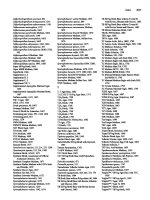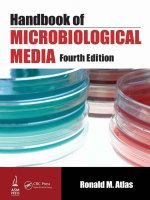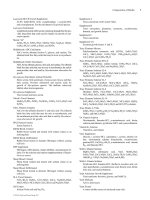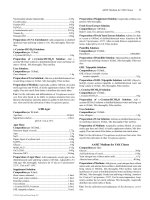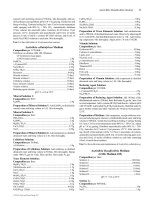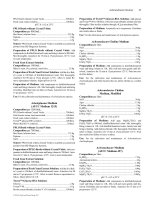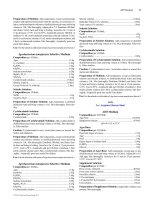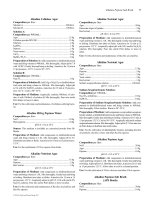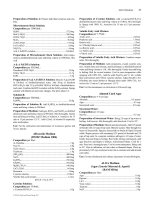Handbook of Microbiological Media, Fourth Edition part 158 pdf
Bạn đang xem bản rút gọn của tài liệu. Xem và tải ngay bản đầy đủ của tài liệu tại đây (220.41 KB, 10 trang )
Serum Glucose Agar, Farrell Modified 1565
Use: For the cultivation and differentiation of Serratia species based
on the fermentation of arabinose and production of ornithine decarboxy-
lase. Serratia marcescens changes the medium to purple throughout the
tube. Serratia liquefaciens changes the medium to a band of purple at
the top of the tube with a green/yellow butt. Serratia rubidaea changes
the medium to yellow throughout the tube.
Serratia Hd-MHr
Composition per liter:
Agar 15.0g
K
2
HPO
4
7.0g
Glucose 5.0g
KH
2
PO
4
3.0g
2-Methyl-
DL-histidine·2HCl 1.0g
(NH
4
)
2
SO
4
1.0g
MgSO
4
·7H
2
O 0.5g
Preparation of Medium: Add components to distilled/deionized
water and bring volume to 1.0L. Mix thoroughly. Gently heat and bring
to boiling. Distribute into tubes or flasks. Autoclave for 15 min at 15
psi pressure–121°C. Pour into sterile Petri dishes or leave in tubes.
Use: For the cultivation and maintenance of Serratia marcescens.
Serratia Medium
(ATCC Medium 181)
Composition per liter:
Agar 20.0g
Pancreatic digest of casein 5.0g
Yeast extract 5.0g
Glucose 1.0g
K
2
HPO
4
1.0g
pH 7.0 ± 0.2 at 25°C
Preparation of Medium: Add components to distilled/deionized
water and bring volume to 1.0L. Mix thoroughly. Gently heat and bring
to boiling. Distribute into tubes or flasks. Autoclave for 15 min at 15
psi pressure–121°C. Pour into sterile Petri dishes or leave in tubes.
Use: For the cultivation and maintenance of Serratia marcescens.
Serratia Medium
(ATCC Medium 1399)
Composition per liter:
Agar 15.0g
K
2
HPO
4
7.0g
Glucose 5.0g
KH
2
PO
4
3.0g
Casein hydrolysate 1.0g
(NH
4
)
2
SO
4
1.0g
Yeast extract 1.0g
MgSO
4
·7H
2
O 0.1g
pH 7.0 ± 0.2 at 25°C
Preparation of Medium: Add components to distilled/deionized
water and bring volume to 1.0L. Mix thoroughly. Gently heat and bring
to boiling. Distribute into tubes or flasks. Autoclave for 15 min at 15
psi pressure–121°C. Pour into sterile Petri dishes or leave in tubes.
Use: For the cultivation and maintenance of Serratia marcescens.
Serum Glucose Agar
(Serum Dextrose Agar)
(ATCC Medium 287)
Composition per 1060.0mL:
Agar 15.0g
Peptone 10.0g
Beef extract 5.0g
NaCl 5.0g
Serum-glucose solution 60.0mL
pH 7.3 ± 0.2 at 25°C
Serum-Glucose Solution:
Composition
per 60.0mL:
D-Glucose 10.0g
Serum (inactivated at 56°C, 30 min) 50.0mL
Preparation of Serum-Glucose Solution: Add glucose to
50.0mL of heat-inactivated serum. Horse serum or ox serum may be
used. Mix thoroughly. Filter sterilize.
Preparation of Medium: Add components, except serum-glucose
solution, to distilled/deionized water and bring volume to 1.0L. Mix
thoroughly. Gently heat and bring to boiling. Autoclave for 15 min at
10 psi pressure–115°C. Cool to 50°C. Aseptically add 60.0mL of ster-
ile serum-glucose solution. Mix thoroughly. Pour into sterile Petri dish-
es or distribute into sterile tubes. Allow tubes to cool in a slanted
position.
Use: For the cultivation and maintenance of Brucella species.
Serum Glucose Agar, Farrell Modified
Composition per 1086.9mL:
Agar 15.0g
Peptone 10.0g
Beef extract 5.0g
NaCl 5.0g
Serum-glucose solution 60.0mL
Bacitracin solution 12.5mL
Cycloheximide solution 10.0mL
Nystatin solution 2.0mL
Polymyxin B solution 1.0mL
Nalidixic acid solution 1.0mL
Vancomycin solution 0.4mL
pH 7.3 ± 0.2 at 25°C
Serum-Glucose Solution:
Composition
per 60.0mL:
D-Glucose 10.0g
Serum (inactivated at 56°C, 30 min) 50.0mL
Preparation of Serum-Glucose Solution: Add glucose to
50.0mL of heat-inactivated serum. Horse serum or ox serum may be
used. Mix thoroughly. Filter sterilize.
Bacitracin Solution:
Composition
per 12.5mL:
Bacitracin 25,000U
Preparation of Bacitracin Solution: Add Bacitracin to distilled/
deionized water and bring volume to 12.5mL. Mix thoroughly. Filter
sterilize.
Cycloheximide Solution:
Composition
per 100.0mL:
Cycloheximide 1.0g
Acetone 5.0mL
© 2010 by Taylor and Francis Group, LLC
1566 Serum Potato Infusion Agar
Preparation of Cycloheximide Solution: Add cycloheximide to
5.0mL of acetone. Mix thoroughly. Bring volume to 100.0mL with dis-
tilled/deionized water. Mix thoroughly. Filter sterilize.
Nystatin Solution:
Composition
per 5.0mL:
Nystatin 250,000U
Preparation of Nystatin Solution: Add nystatin to distilled/de-
ionized water and bring volume to 5.0mL. Mix thoroughly. Filter ster-
ilize.
Polymyxin B Solution:
Composition
per 2.0mL:
Polymyxin B 10,000U
Preparation of Polymyxin B Solution: Add polymyxin B to dis-
tilled/deionized water and bring volume to 2.0mL. Mix thoroughly. Fil-
ter sterilize.
Nalidixic Acid Solution:
Composition
per 2.0mL:
Nalidixic acid 0.1g
NaOH (0.5N solution) 2.0mL
Preparation of Nalidixic Acid Solution: Add nalidixic acid to
2.0mL of NaOH solution. Mix thoroughly. Immediately before use,
add 1.0mL of this stock solution to 9.0mL of distilled/deionized water.
Mix thoroughly. Filter sterilize.
Vancomycin Solution:
Composition
per 1.0mL:
Vancomycin 0.05g
Preparation of Vancomycin Solution: Add vancomycin to dis-
tilled/deionized water and bring volume to 1.0mL. Mix thoroughly. Fil-
ter sterilize.
Preparation of Medium: Add components—except serum-glucose
solution, bacitracin solution, cycloheximide solution, nystatin solution,
polymyxin B solution, nalidixic acid solution, and vancomycin solu-
tion—to distilled/deionized water and bring volume to 1.0L. Mix thor-
oughly. Gently heat and bring to boiling. Autoclave for 15 min at 10 psi
pressure–115°C. Cool to 50°C. Aseptically add 60.0mL of sterile se-
rum-glucose solution, 12.5mL of sterile bacitracin solution, 10.0mL of
sterile cycloheximide solution, 2.0mL of sterile nystatin solution,
1.0mL of sterile polymyxin B solution, 1.0mL of sterile nalidixic acid
solution, and 0.4mL of sterile vancomycin solution. Mix thoroughly.
Pour into sterile Petri dishes or distribute into sterile tubes. Allow tubes
to cool in a slanted position.
Use: For the selective isolation and cultivation of Brucella species.
Serum Potato Infusion Agar
Composition per 1120.0mL:
Agar 15.0g
Peptone 10.0g
Meat extract 5.0g
NaCl 5.0g
Potato infusion 1.0L
Horse serum, heat inactivated 100.0mL
Glycerol 20.0mL
pH 6.8 ± 0.2 at 25°C
Potato Infusion:
Composition
per 10.0mL:
Potatoes 250.0g
Preparation of Potato Infusion: Add peeled, thinly sliced pota-
toes to 1.0L of distilled/deionized water. Infuse overnight at 60°C. Fil-
ter through Whatman #1 filter paper. Bring volume to 1.0L with
distilled/deionized water.
Preparation of Medium: Combine components, except horse se-
rum. Mix thoroughly. Gently heat and bring to boiling. Autoclave for
15 min at 15 psi pressure–121°C. Cool to 45°–50°C. Aseptically add
100.0mL of sterile horse serum. Mix thoroughly. Pour into sterile Petri
dishes or distribute into sterile tubes.
Use: For the cultivation of Brucella species.
Serum Tellurite Agar
Composition per liter:
Agar 20.0g
Pancreatic digest of casein 10.0g
Peptic digest of animal tissue 10.0g
NaCl 5.0g
Glucose 2.0g
Lamb serum 50.0mL
Chapman tellurite solution 10.0mL
pH 7.5 ± 0.2 at 25°C
Source: This medium is available as a premixed powder from BD Di-
agnostic Systems.
Chapman Tellurite Solution:
Composition per 100.0mL:
K
2
TeO
3
1.0g
Preparation of Chapman Tellurite Solution: Add K
2
TeO
3
to
distilled/deionized water and bring volume to 100.0mL. Mix thorough-
ly. Filter sterilize.
Preparation of Medium: Add components, except lamb serum and
Chapman tellurite solution, to distilled/deionized water and bring vol-
ume to 940.0mL. Mix thoroughly. Gently heat and bring to boiling.
Autoclave for 15 min at 15 psi pressure–121°C. Cool to 45°–50°C.
Aseptically add sterile lamb serum and 10.0mL of sterile Chapman tel-
lurite solution. Mix thoroughly. Pour into sterile Petri dishes or distrib-
ute into sterile tubes.
Use: For the isolation and cultivation of Corynebacterium species,
especially in the laboratory diagnosis of diphtheria.
Seven H11 Agar
(Selective 7H11 Agar)
Composition per 1010.0mL:
Agar 13.5g
KH
2
PO
4
1.5g
Na
2
HPO
4
1.5g
Pancreatic digest of casein 1.0g
NaCl 0.85g
Monosodium glutamate 0.5g
(NH
4
)
2
SO
4
0.5g
Sodium citrate 0.4g
MgSO
4
·7H
2
O 0.05g
Ferric ammonium citrate 0.04g
CuSO
4
·5H
2
O 1.0mg
Pyridoxine 1.0mg
ZnSO
4
·7H
2
O 1.0mg
Biotin 0.5mg
CaCl
2
·2H
2
O 0.5mg
Malachite Green 0.25mg
© 2010 by Taylor and Francis Group, LLC
SF1 Medium 1567
Middlebrook OADC enrichment 100.0mL
Antibiotic inhibitor 10.0mL
Glycerol 5.0mL
pH 6.6 ± 0.2 at 25°C
Source: This medium is available as a prepared medium from BD Di-
agnostic Systems.
Middlebrook OADC Enrichment:
Composition
per liter:
Bovine albumin fraction V 5.0g
Glucose 2.0g
NaCl 0.85g
Catalase 3.0mg
Oleic acid 0.06mL
Preparation of Middlebrook OADC Enrichment: Add com-
ponents to distilled/deionized water and bring volume to 100.0mL.
Mix thoroughly. Filter sterilize.
Antibiotic Inhibitor:
Composition
per 10.0mL:
Carbenicillin 0.05g
Trimethoprim lactate 0.02g
Amphotericin B 0.01g
Polymyxin B 200,000U
Preparation of Antibiotic Inhibitor: Add components to dis-
tilled/deionized water and bring volume to 10.0mL. Mix thoroughly.
Filter sterilize.
Preparation of Medium: Add glycerol to 900.0mL of distilled/de-
ionized water. Mix thoroughly. Add remaining components, except
Middlebrook OADC enrichment and antibiotic inhibitor. Mix thor-
oughly. Gently heat. Do not boil. Autoclave for 10 min at 15 psi pres-
sure–121°C. Cool to 50°–55°C. Aseptically add 100.0mL of sterile
Middlebrook OADC enrichment and 10.0mL of sterile antibiotic solu-
tion. Mix thoroughly. Pour into sterile Petri dishes or distribute into
sterile tubes.
Use: For the isolation and cultivation of Mycobacterium species from
specimens with a mixed flora.
Seven-Hour Fecal Coliform Agar
(Seven-Hour FC Agar)
(m-Seven-Hour Fecal Coliform Agar)
Composition per liter:
Agar 15.0g
Lactose 10.0g
NaCl 7.5g
D-Mannitol 5.0g
Proteose peptone No. 3 5.0g
Yeast extract 3.0g
Bromcresol Purple 0.35g
Phenol Red 0.3g
Sodium lauryl sulfate 0.2g
Sodium deoxycholate 0.1g
pH 7.3 ± 0.1 at 25°C
Preparation of Medium: Add components to distilled/deionized
water and bring volume to 1.0L. Mix thoroughly. Gently heat and bring
to boiling. Continue boiling for 5 min. Cool to 55°–60°C. Adjust pH to
7.3 with 0.1N NaOH. Cool to 45°–50°C. Pour into sterile Petri dishes
with tight-fitting lids in 5.0mL volumes. Store at 2°–10°C.
Use: For the rapid estimation of the bacteriological quality of water
using the membrane filter method.
SF Broth
(Streptococcus faecalis Broth)
Composition per liter:
Pancreatic digest of casein 20.0g
Glucose 5.0g
NaCl 5.0g
K
2
HPO
4
4.0g
KH
2
PO
4
1.5g
NaN
3
0.5g
Bromcresol Purple 0.032g
pH 6.9 ± 0.2 at 25°C
Source: This medium is available as a premixed powder from BD Di-
agnostic Systems.
Preparation of Medium: Add components to distilled/deionized
water and bring volume to 1.0L. Mix thoroughly. Distribute into tubes
or flasks. Autoclave for 15 min at 15 psi pressure–121°C.
Use: For the cultivation and differentiation of group D enterococci
(Streptococcus faecalis and Streptococcus faecium) from group D non-
enterococci and from other Streptococcus species. Group D entero-
cocci turn the medium turbid and yellow-brown.
SF HiVeg Broth
Composition per liter:
Plant hydrolysate 20.0g
Glucose 5.0g
NaCl 5.0g
K
2
HPO
4
4.0g
KH
2
PO
4
1.5g
NaN
3
0.5g
Bromcresol Purple 0.032
pH 6.9 ± 0.2 at 25°C
Source: This medium is available as a premixed powder from Hi-
Media.
Preparation of Medium: Add components to distilled/deionized
water and bring volume to 1.0L. Mix thoroughly. Distribute into tubes
or flasks. Autoclave for 15 min at 15 psi pressure–121°C.
Use: For the cultivation and differentiation of group D enterococci
(Streptococcus faecalis and Streptococcus faecium) from group D non-
enterococci and from other Streptococcus species. Group D entero-
cocci turn the medium turbid and yellow-brown.
SF1 Medium
Composition per liter:
NaCl 120.0g
MgCl
2
·6H
2
O 7.0g
MgSO
4
·7H
2
O 6.0g
KCl 3.8g
Pancreatic digest of casein 2.0g
Yeast extract 2.0g
NH
4
Cl 1.0g
CaCl
2
·2H
2
O 0.5g
L-Cysteine·HCl 0.5g
K
2
HPO
4
·3H
2
O .0.4g
Resazurin 1.0mg
Na
2
SeO
3
·5H
2
O 75.0μg
Na
2
CO
3
solution 20.0mL
© 2010 by Taylor and Francis Group, LLC
1568 SFP Agar
Trimethylamine·HCl solution 20.0mL
Na
2
S·9H
2
O solution 10.0mL
Trace elements solution SL-10 1.0mL
NaOH (10M solution) 0.6mL
pH 7.3 ± 0.2 at 25°C
Na
2
CO
3
Solution:
Composition
per 20.0mL:
Na
2
CO
3
10.0mg
Preparation of Na
2
CO
3
Solution: Add Na
2
CO
3
to distilled/deion-
ized water and bring volume to 20.0mL. Mix thoroughly. Sparge under
100% N
2
. Autoclave for 15 min at 15 psi pressure–121°C. Store under
N
2
.
Trimethylamine·HCl Solution:
Composition
per 20.0mL:
Trimethylamine·HCl 10.0mg
Preparation of Trimethylamine·HCl Solution: Add trimethyl-
amine·HCl to distilled/deionized water and bring volume to 20.0mL.
Mix thoroughly. Sparge under 100% N
2
. Autoclave for 15 min at 15 psi
pressure–121°C. Store under N
2
.
Na
2
S·9H
2
O Solution:
Composition
per 10.0mL:
Na
2
S·9H
2
O 10.0mg
Preparation of Na
2
S·9H
2
O Solution: Add Na
2
S·9H
2
O to dis-
tilled/deionized water and bring volume to 10.0mL. Mix thoroughly.
Sparge under 100% N
2
. Autoclave for 15 min at 15 psi pressure–
121°C. Store under N
2
.
Trace Elements Solution SL-10:
Composition
per liter:
FeCl
2
·4H
2
O 1.5g
CoCl
2
·6H
2
O 190.0mg
MnCl
2
·4H
2
O 100.0mg
ZnCl
2
70.0mg
Na
2
MoO
4
·2H
2
O 36.0mg
NiCl
2
·6H
2
O 24.0mg
H
3
BO
3
6.0mg
CuCl
2
·2H
2
O 2.0mg
HCl (25% solution) 10.0mL
Preparation of Trace Elements Solution SL-10: Add FeCl
2
·4H
2
O
to 10.0mL of HCl solution. Mix thoroughly. Add distilled/deionized
water and bring volume to 1.0L. Add remaining components. Mix thor-
oughly. Sparge with 80% N
2
+ 20% CO
2
. Autoclave for 15 min at 15
psi pressure–121°C.
Preparation of Medium: Prepare and dispense medium under 80%
N
2
+ 20% CO
2
. Add components, except L-cysteine·HCl, NaOH,
Na
2
CO
3
solution, trimethylamine·HCl solution, and Na
2
S·9H
2
O solu-
tion, to distilled/deionized water and bring volume to 950.0mL. Mix
thoroughly. Gently heat and bring to boiling. Continue boiling for 5
min. Cool to room temperature while sparging with 80% N
2
+ 20%
CO
2
. Add L-cysteine·HCl and NaOH while contiuning to sparge with
80% N
2
+ 20% CO
2
. Adjust pH to 6.7. Anaerobically distribute into
tubes or bottles. Autoclave for 15 min at 15 psi pressure–121°C. Asep-
tically and anaerobically add 20.0mL of sterile trimethylamine·HCl so-
lution, 20.0mL of sterile Na
2
CO
3
solution, and 10.0mL of sterile
Na
2
S·9H
2
O solution per 950.0mL of medium. Check that final pH is
6.7.
Use: For the cultivation and maintenance of Methanohalophilus species.
SFP Agar
(Shahidi-Ferguson Perfringens Agar)
Composition per 2020.0mL:
Basal layer 1010.0mL
Cover layer 1010.0mL
Source: This medium is available as a premixed powder from BD Di-
agnostic Systems and Oxoid Unipath.
Basal Layer:
Composition
per 1010.0mL:
Agar 20.0g
Tryptose 15.0g
Papaic digest of soybean meal 5.0g
Yeast extract 5.0g
Ferric ammonium citrate 1.0g
NaHSO
3
1.0g
Egg yolk emulsion, 50% 100.0mL
Antibiotic inhibitor 10.0mL
pH 7.6 ± 0.2 at 25°C
Egg Yolk Emulsion, 50%:
Composition per 100.0mL:
Chicken egg yolks 11
Whole chicken egg 1
NaCl (0.9% solution) 50.0mL
Preparation of Egg Yolk Emulsion, 50%: Soak eggs with 1:100
dilution of saturated mercuric chloride solution for 1 min. Crack eggs
and separate yolks from whites. Mix egg yolks with 1 chicken egg.
Beat to form emulsion. Measure 50.0mL of egg yolk emulsion and add
to 50.0mL of 0.9% NaCl solution. Mix thoroughly. Filter sterilize.
Warm to 45°–50°C.
Antibiotic Inhibitor:
Composition
per 10.0mL:
Kanamycin 0.012g
Polymyxin B sulfate 30,000U
Preparation of Antibiotic Inhibitor: Add components to dis-
tilled/deionized water and bring volume to 10.0mL. Mix thoroughly.
Filter sterilize.
Preparation of Basal Layer: Add components—except egg yolk
emulsion, 50%, and antibiotic inhibitor—to distilled/deionized water
and bring volume to 990.0mL. Mix thoroughly. Gently heat and bring
to boiling. Autoclave for 15 min at 15 psi pressure–121°C. Cool to
45°–50°C. Aseptically add sterile egg yolk emulsion, 50%, and antibi-
otic inhibitor. Mix thoroughly. Pour into sterile Petri dishes in 10.0mL
volumes.
Cover Layer:
Composition
per 1010.0mL:
Agar 20.0g
Tryptose 15.0g
Papaic digest of soybean meal 5.0g
Yeast extract 5.0g
Ferric ammonium citrate 1.0g
NaHSO
3
1.0g
Antibiotic inhibitor 10.0mL
pH 7.6 ± 0.2 at 25°C
Preparation of Cover Layer: Add components—except antibiotic
inhibitor—to distilled/deionized water and bring volume to 1.0L. Mix
thoroughly. Gently heat and bring to boiling. Autoclave for 15 min at
15 psi pressure–121°C. Cool to 45°–50°C. Aseptically add sterile anti-
biotic inhibitor. Mix thoroughly.
© 2010 by Taylor and Francis Group, LLC
Shapton HiVeg Medium 1569
Preparation of Medium: Prepare and dispense basal layer into
sterile Petri dishes in 10.0mL volumes. Incubate overnight to dry plates
and test for sterility. Inoculate plates using 0.1mL volume. Spread in-
oculum over suface of agar. Aseptically add 10.0mL of cover layer to
each plate. Incubate at 37°C under 90% N
2
+ 10% CO
2
.
Use: For the isolation and enumeration of Clostridium perfringens
from foods. Clostridium perfringens appears as black colonies sur-
rounded by a precipitate.
S.F.P. HiVeg Agar Base with Egg Yolk and Antibiotics
Composition per liter:
Basal layer 500.0mL
Cover layer 500.0mL
Basal Layer:
Composition
per liter:
Agar 20.0g
Plant hydrolysate No. 1 15.0g
Yeast extract 5.0g
Papaic digest of soybean meal 5.0g
NaHSO
3
1.0g
Ferric ammonium citrate 1.0g
Egg yolk emulsion, 50% 100.0mL
Antibiotic inhibitor 10.0mL
pH 7.6 ± 0.2 at 25°C
Source: This medium, without egg yolk emulsion and antibiotic in-
hibito, is available as a premixed powder from HiMedia.
Egg Yolk Emulsion, 50%:
Composition per 100.0mL:
Chicken egg yolks 11
Whole chicken egg 1
NaCl (0.9% solution) 50.0mL
Preparation of Egg Yolk Emulsion, 50%: Soak eggs with 1:100
dilution of saturated mercuric chloride solution for 1 min. Crack eggs
and separate yolks from whites. Mix egg yolks with 1 chicken egg.
Beat to form emulsion. Measure 50.0mL of egg yolk emulsion and add
to 50.0mL of 0.9% NaCl solution. Mix thoroughly. Filter sterilize.
Warm to 45°–50°C.
Antibiotic Inhibitor:
Composition
per 10.0mL:
Kanamycin 0.012g
Polymyxin B sulfate 30,000U
Preparation of Antibiotic Inhibitor: Add components to dis-
tilled/deionized water and bring volume to 10.0mL. Mix thoroughly.
Filter sterilize.
Preparation of Basal Layer: Add components—except egg yolk
emulsion, 50%, and antibiotic inhibitor—to distilled/deionized water
and bring volume to 990.0mL. Mix thoroughly. Gently heat and bring
to boiling. Autoclave for 15 min at 15 psi pressure–121°C. Cool to
45°–50°C. Aseptically add sterile egg yolk emulsion, 50%, and antibi-
otic inhibitor. Mix thoroughly. Pour into sterile Petri dishes in 10.0mL
volumes.
Cover Layer:
Composition
per 1010.0mL:
Agar 20.0g
Tryptose 15.0g
Papaic digest of soybean meal 5.0g
Yeast extract 5.0g
Ferric ammonium citrate 1.0g
NaHSO
3
1.0g
Antibiotic inhibitor 10.0mL
pH 7.6 ± 0.2 at 25°C
Antibiotic Inhibitor:
Composition
per 10.0mL:
Kanamycin 0.012g
Polymyxin B sulfate 30,000U
Preparation of Antibiotic Inhibitor: Add components to dis-
tilled/deionized water and bring volume to 10.0mL. Mix thoroughly.
Filter sterilize.
Preparation of Cover Layer: Add components—except antibiotic
inhibitor—to distilled/deionized water and bring volume to 1.0L. Mix
thoroughly. Gently heat and bring to boiling. Autoclave for 15 min at
15 psi pressure–121°C. Cool to 45°–50°C. Aseptically add sterile anti-
biotic inhibitor. Mix thoroughly.
Preparation of Medium: Prepare and dispense basal layer into
sterile Petri dishes in 10.0mL volumes. Incubate overnight to dry plates
and test for sterility. Inoculate plates using 0.1mL volume. Spread in-
oculum over suface of agar. Aseptically add 10.0mL of cover layer to
each plate. Incubate at 37°C under 90% N
2
+ 10% CO
2
.
Use: For the isolation and enumeration of Clostridium perfringens
from foods. Clostridium perfringens appears as black colonies sur-
rounded by a precipitate.
SG Agar
Composition per liter:
Agar 15.0g
Pancreatic digest of casein 15.0g
CaCl
2
·2H
2
O 2.0g
MgSO
4
·7H
2
O 1.0g
pH 7.0 ± 0.2 at 25°C
Preparation of Medium: Add components to distilled/deionized
water and bring volume to 1.0L. Mix thoroughly. Gently heat and bring
to boiling. Distribute into tubes or flasks. Autoclave for 15 min at 15
psi pressure–121°C. Pour into sterile Petri dishes or leave in tubes.
Use: For the cultivation of myxobacteria.
Shapton HiVeg Medium
Composition per liter:
Agar 15.0g
Plant peptone 5.0g
Plant extract 3.0g
Plant hydrolysate 2.5g
Yeast extract 1.0g
Glucose 1.0g
Bromcresol Purple 0.025g
pH 7.4 ± 0.2 at 25°C
Source: This medium is available as a premixed powder from Hi-
Media.
Preparation of Medium: Add components to distilled/deionized
water and bring volume to 1.0L. Mix thoroughly. Gently heat while
stirring and bring to boiling. Autoclave for 15 min at 15 psi pressure–
121°C. Mix thoroughly. Pour into sterile Petri dishes.
Use: For the cultivation of aciduric and thermophilic flat sour spore-
formers. For the enumeration of spores of Bacillus stearothermophilus
which cause flat sour spoilage in canned foods with pH more than 4.5.
© 2010 by Taylor and Francis Group, LLC
1570 Shapton Medium
Shapton Medium
Composition per liter:
Agar 15.0g
Peptic digest of animal tissue 5.0g
Beef extract 3.0g
Casein enzymic hydrolysate 2.5g
Glucosec 1.0g
Yeast extract 1.0g
Bromo Cresol Purple 0.025g
pH 6.0 ± 0.2 at 25°C
Source: This medium is available as a premixed powder from Hi-
Media.
Preparation of Medium: Add components to distilled/deionized
water and bring volume to 1.0L. Mix thoroughly. Gently heat while
stirring and bring to boiling. Autoclave for 15 min at 15 psi pressure–
121°C. Mix thoroughly. Pour into sterile Petri dishes.
Use: For the cultivation of aciduric and thermophilic flat sour spore-
formers. For the enumeration of spores of Bacillus stearothermophilus
which cause flat sour spoilage in canned foods with pH more than 4.5.
Sheep Blood Agar
(BAM M135)
Composition per liter:
Proteose peptone 15.0g
Agar 12.0g
Liver digest 2.5g
Yeast extract 5.0g
NaCl 5.0g
Sheep blood, defibrinated 50.0mL
pH 7.3 ± 0.2 at 25°C
Source: This medium is available as a premixed powder from Oxoid
Unipath.
Preparation of Medium: Add components, except sheep blood, to
distilled/deionized water and bring volume to 950.0mL. Mix thorough-
ly. Heat with frequent agitation and boil for 1 min to completely dis-
solve. Autoclave for 15 min at 15 psi pressure–121°C. Cool to 45°–
46°C. Aseptically add 50.0mL of sterile, defibrinated sheep blood. Mix
thoroughly and pour into sterile Petri dishes.
Use: For the isolation, cultivation, and detection of hemolytic activity
of streptococci and other fastidious microorganisms.
Sheep Blood Agar
Composition per liter:
Tryptone 14.0g
Agar 12.0g
NaCl 5.0g
Peptone, neutralized 4.5g
Yeast extract 4.5g
Sheep blood, defibrinated 70.0mL
pH 7.4 ± 0.2 at 25°C
Source: This medium is available as a premixed powder from Oxoid
Unipath.
Preparation of Medium: Add components, except sheep blood, to
distilled/deionized water and bring volume to 930.0mL. Mix thorough-
ly. Heat with frequent agitation and boil for 1 min to completely dis-
solve. Autoclave for 15 min at 15 psi pressure–121°C. Cool to 50°C.
Aseptically add 70.0mL of sterile, defibrinated sheep blood. Mix thor-
oughly and pour into sterile Petri dishes.
Use: For the isolation, cultivation, and detection of hemolytic activity
of streptococci and other fastidious microorganisms. Specifically for-
mulated to give maximum recovery and improved hemolytic reactions
with sheep blood.
Shepard’s Differential Agar
See: A7 Agar
Shepard’s M10 Medium
See: Standard Fluid Medium 10B
Shigella Broth
Composition per liter:
Pancreatic digest of casein 20.0g
NaCl 5.0g
K
2
HPO
4
2.0g
KH
2
PO
4
2.0g
Glucose 1.0g
Novobiocin solution 11.1mL
Tween
™ 80 1.5mL
pH 7.0 ± 0.2 at 25°C
Novobiocin Solution:
Composition
per liter:
Novobiocin 0.05g
Preparation of Novobiocin Solution: Add novobiocin to dis-
tilled/deionized water and bring volume to 1.0L. Mix thoroughly. Filter
sterilize.
Preparation of Medium: Add components, except novobiocin so-
lution, to distilled/deionized water and bring volume to 988.9mL. Mix
thoroughly. Gently heat and bring to boiling. Autoclave for 15 min at
15 psi pressure–121°C. Cool to 45°–50°C. Aseptically add sterile no-
vobiocin solution. Mix thoroughly. Aseptically distribute into sterile
tubes.
Use: For the isolation and cultivation of Shigella species from food.
Shigella HiVeg Broth Base with Novobiocin
Composition per liter:
Plant hydrolysate 20.0g
NaCl 5.0g
K
2
HPO
4
2.0g
KH
2
PO
4
2.0g
Glucose 1.0g
Polysorbate 80 1.5 ml
Novobiocin solution 11.1mL
pH 7.0 ± 0.2 at 25°C
Source: This medium, without novobiocin, is available as a premixed
powder from HiMedia.
Novobiocin Solution:
Composition
per liter:
Novobiocin 0.05g
Preparation of Novobiocin Solution: Add novobiocin to dis-
tilled/deionized water and bring volume to 1.0L. Mix thoroughly. Filter
sterilize.
Preparation of Medium: Add components, except novobiocin so-
lution, to distilled/deionized water and bring volume to 988.9mL. Mix
thoroughly. Gently heat and bring to boiling. Autoclave for 15 min at
15 psi pressure–121°C. Cool to 45°–50°C. Aseptically add sterile no-
© 2010 by Taylor and Francis Group, LLC
SIM HiVeg Medium 1571
vobiocin solution. Mix thoroughly. Aseptically distribute into sterile
tubes.
Use: For the isolation and cultivation of Shigella species from food.
Shiitake Agar
Composition per liter:
Malt extract 20.0g
Agar 15.0g
Yeast extract 1.0g
pH 7.0 ± 0.2 at 25°C
Preparation of Medium: Add components to distilled/deionized
water and bring volume to 1.0L. Mix thoroughly. Adjust pH to 7.0.
Gently heat and bring to boiling. Distribute into tubes or flasks. Auto-
clave for 15 min at 15 psi pressure–121°C. Pour into sterile Petri dishes
or leave in tubes.
Use: For the cultivation and maintenance of Lentinula edodes, Ochro-
bactrum anthropi, and Pseudomonas species.
SI Agar
Composition per liter:
Peptone 15.6g
Agar 12.0g
NaCl 5.6g
Yeast extract 2.8g
D-Glucose 1.0g
pH 7.5 ± 0.2 at 25°C
Preparation of Medium: Add components to distilled/deionized
water and bring volume to 1.0L. Mix thoroughly. Gently heat and bring
to boiling. Distribute into tubes or flasks. Autoclave for 15 min at 15
psi pressure–121°C. Pour into sterile Petri dishes or leave in tubes.
Use: For the cultivation and maintenance of Escherichia coli.
Siderophore Mineral Medium
Composition per liter:
KH
2
PO
4
8.2g
NaOH 1.6g
NH
4
Cl 1.0g
KCl 0.5g
CaSO
4
·2H
2
O 0.5mg
CuSO
4
·5H
2
O 0.5mg
FeCl
3
·6H
2
O 0.5mg
ZnSO
4
·7H
2
O 0.5mg
Deferrioxamine B solution 10.0mL
MgSO
4
·7H
2
O solution 10.0mL
Wolfe’s vitamin solution 5.0mL
Deferrioxamine B Solution:
Composition
per 10.0mL:
Deferrioxamine B 1.0g
Preparation of Deferrioxamine B Solution: Add deferrioxam-
ine B to distilled/deionized water and bring volume to 10.0mL. Mix
thoroughly. Filter sterilize.
MgSO
4
·7H
2
O Solution:
Composition
per 10.0mL:
MgSO
4
·7H
2
O 0.5g
Preparation of MgSO
4
·7H
2
O Solution: Add MgSO
4
·7H
2
O to
distilled/deionized water and bring volume to 10.0mL. Mix thorough-
ly. Filter sterilize.
Wolfe’s Vitamin Solution:
Composition per liter:
Pyridoxine·HCl 0.01g
Thiamine·HCl 5.0mg
Riboflavin 5.0mg
Nicotinic acid 5.0mg
Calcium pantothenate 5.0mg
p-Aminobenzoic acid 5.0mg
Thioctic acid 5.0mg
Biotin 2.0mg
Folic acid 2.0mg
Cyanocobalamin 0.1mg
Preparation of Wolfe’s Vitamin Solution: Add components to
distilled/deionized water and bring volume to 1.0L. Mix thoroughly. Fil-
ter sterilize.
Preparation of Medium: Add components—except deferrioxam-
ine B solution, MgSO
4
·7H
2
O solution, and Wolfe’s vitamin solution—
to distilled/deionized water and bring volume to 975.0mL. Mix thor-
oughly. Gently heat and bring to boiling. Autoclave for 15 min at 15 psi
pressure–121°C. Cool to 45°–50°C. Aseptically add 10.0mL of sterile
deferrioxamine B solution, 10.0mL of sterile MgSO
4
·7H
2
O solution,
and 5.0mL of sterile Wolfe’s vitamin solution. Mix thoroughly. Pour
into sterile Petri dishes or distribute into sterile tubes.
Use: For the cultivation of ATCC strain 49538.
Sierra Medium
Composition per liter:
Agar 15.0g
Peptone 10.0g
NaCl 5.0g
CaCl
2
·H
2
O 0.1g
Tween™ 80 10.0mL
pH 7.4 ± 0.2 at 25°C
Preparation of Medium: Add components, except Tween™ 80, to
distilled/deionized water and bring volume to 990.0mL. Mix thoroughly.
Gently heat and bring to boiling. Autoclave for 15 min at 15 psi pres-
sure–121°C. Cool to 45°–50°C. Separately autoclave Tween™ 80 for 15
min at 15 psi pressure–121°C. Cool to 45°–50°C. Aseptically add
10.0mL of sterile Tween™ 80. Mix thoroughly. Pour into sterile Petri
dishes.
Use: For the differentiation of bacteria based on lipase activity. Bacte-
ria with lipase activity form colonies surrounded by a white precipitate.
SIM HiVeg Medium
Composition per liter:
Plant peptone 30.0g
Agar 3.0g
Plant extract 3.0g
HiVeg peptonized iron 0.2g
Na
2
S
2
O
3
0.025g
pH 7.3 ± 0.2 at 25°C
Source: This medium is available as a premixed powder from Hi-
Media.
Preparation of Medium: Add components to distilled/deionized
water and bring volume to 1.0L. Mix thoroughly. Gently heat and bring
to boiling. Distribute into tubes in 15.0mL volumes. Autoclave for 15
min at 15 psi pressure–121°C. Allow tubes to cool in an upright posi-
tion.
© 2010 by Taylor and Francis Group, LLC
1572 SIM Medium
Use: For the determination of hydrogen sulfide production, indole for-
mation, and motility of enteric bacilli.
SIM Medium
Composition per liter:
Peptone 30.0g
Agar 3.0g
Beef extract 3.0g
Peptonized iron 0.2g
Na
2
S
2
O
3
·5H
2
O 0.025g
pH 7.3 ± 0.2 at 25°C
Source: This medium is available as a premixed powder from BD Di-
agnostic Systems.
Preparation of Medium: Add components to distilled/deionized
water and bring volume to 1.0L. Mix thoroughly. Gently heat and bring
to boiling. Distribute into tubes in 15.0mL volumes. Autoclave for 15
min at 15 psi pressure–121°C. Allow tubes to cool in an upright posi-
tion.
Use: For the differentiation of members of the Enterobacteriaceae based
on H
2
S production, indole production, and motility.
SIM Medium
Composition per liter:
Pancreatic digest of casein 20.0g
Peptic digest of animal tissue 6.1g
Agar 3.5g
Fe(NH
4
)
2
(SO
4
)
2
·6H
2
O 0.2g
Na
2
S
2
O
3
·5H
2
O 0.2g
pH 7.3 ± 0.2 at 25°C
Source: This medium is available as a premixed powder from BD Di-
agnostic Systems and Oxoid Unipath.
Preparation of Medium: Add components to distilled/deionized
water and bring volume to 1.0L. Mix thoroughly. Gently heat and bring
to boiling. Distribute into tubes in 15.0mL volumes. Autoclave for 15
min at 15 psi pressure–121°C. Allow tubes to cool in an upright posi-
tion.
Use: For the differentiation of members of the Enterobacteriaceae based
on H
2
S production, indole production, and motility.
SIM Motility Medium
(BAM M137)
Composition per liter:
Pancreatic digest of casein 20.0g
Peptic digest of animal tissue 6.1g
Agar 3.5g
Fe(NH
4
)
2
(SO
4
)
2
·6H
2
O 0.2g
Na
2
S
2
O
3
·5H
2
O 0.2g
pH 7.3 ± 0.2 at 25°C
Source: This medium is available as a premixed powder from BD Di-
agnostic Systems and Oxoid Unipath.
Preparation of Medium: Add components to distilled/deionized
water and bring volume to 1.0L. Mix thoroughly. Gently heat and bring
to boiling. Distribute into tubes in 15.0mL volumes. Autoclave for 15
min at 15 psi pressure–121°C. Allow tubes to cool in an upright posi-
tion.
Use: For the differentiation of members of the Enterobacteriaceae based
on H
2
S production, indole production, and motility.
Simmons’ Citrate Agar
(Citrate Agar)
Composition per liter:
Agar 15.0g
NaCl 5.0g
Sodium citrate 2.0g
K
2
HPO
4
1.0g
(NH
4
)H
2
PO
4
1.0g
MgSO
4
·7H
2
O 0.2g
Bromthymol Blue 0.08g
pH 6.9 ± 0.2 at 25°C
Source: This medium is available as a premixed powder from BD Di-
agnostic Systems and Oxoid Unipath.
Preparation of Medium: Add components to distilled/deionized
water and bring volume to 1.0L. Mix thoroughly. Gently heat while
stirring and bring to boiling. Distribute into tubes or flasks. Autoclave
for 15 min at 15 psi pressure–121°C. Pour into sterile Petri dishes or
leave in tubes.
Use: For the differentiation of Gram-negative bacteria on the basis of
citrate utilization. Bacteria that can utilize citrate as sole carbon source
turn the medium blue.
Simmons’ Citrate Agar, Modified
See: Acetate Differential Agar
Simonsiella Agar
(LMG Medium 31)
Composition per liter:
Tryptone 17.0g
Agar 15.0g
NaCl 5.0g
Yeast extract 4.0g
Soy peptone 3.0g
K
2
HPO
4
2.5g
Bovine serum 100.0mL
pH 7.2 ± 0.2 at 25°C
Preparation of Medium: Add components, except bovine serum,
to distilled/deionized water and bring volume to 900.0mL. Mix thor-
oughly. Gently heat and bring to boiling. Autoclave for 15 min at 15 psi
pressure–121°C. Cool to 45°–50°C. Aseptically add 100.0mL sterile
bovine serum. Mix thoroughly. Pour into sterile Petri dishes or distrib-
ute into sterile tubes.
Use: For the cultivation of Simonsiella spp.
Simonsiella Agar
Composition per liter:
Pancreatic digest of casein 17.0g
Agar 15.0g
NaCl 5.0g
Yeast extract 4.0g
Papaic digest of soybean meal 3.0g
K
2
HPO
4
2.5g
Horse serum 100.0mL
Preparation of Medium: Add components, except horse serum, to
distilled/deionized water and bring volume to 900.0mL. Mix thorough-
ly. Gently heat and bring to boiling. Autoclave for 15 min at 15 psi
pressure–121°C. Cool to 50°–55°C. Aseptically add 100.0mL of sterile
© 2010 by Taylor and Francis Group, LLC
Single-Layer Agar 1573
horse serum warmed to 50°–55°C. Mix thoroughly. Pour into sterile
Petri dishes or distribute into sterile tubes.
Use: For the cultivation and maintenance of Simonsiella muelleri and
Simonsiella steedae.
Simonsiella Broth
Composition per liter:
Pancreatic digest of casein 17.0g
NaCl 5.0g
Yeast extract 4.0g
Papaic digest of soybean meal 3.0g
K
2
HPO
4
2.5g
Horse serum 100.0mL
Preparation of Medium: Add components, except horse serum, to
distilled/deionized water and bring volume to 900.0mL. Mix thoroughly.
Autoclave for 15 min at 15 psi pressure–121°C. Aseptically add 100.0mL
of sterile bovine serum. Mix thoroughly. Aseptically distribute into sterile
tubes or flasks.
Use: For the cultivation and maintenance of Simonsiella muelleri and
Simonsiella steedae.
Simulated Grape Juice Medium
Composition per liter:
Glucose 16.0g
Tartaric acid 0.5g
pH 6.6 ± 0.2 at 25°C
Source: This medium is available as a premixed powder from Hi-
Media.
Preparation of Medium: Add components to distilled/deionized
water and bring volume to 1.0L. Mix thoroughly. Distribute into tubes
or flasks. Autoclave for 15 min at 15 psi pressure–121°C.
Use: For the cultivation of microorganisms associated with winemak-
ing.
Singh’s Medium, Modified
Composition per liter:
NaCl 8.75g
Lactalbumin hydrolysate 8.13g
Yeast extract 6.25g
D-Glucose 5.0g
CaCl
2
·2H
2
O 0.25g
KCl 0.25g
NaH
2
PO
4
·H
2
O 0.25g
NaHCO
3
0.15g
MgCl
2
·6H
2
O 0.13g
Phenol Red 0.01g
Fetal bovine serum
(heat inactivated at 56°C, 30 min) 200.0mL
pH 7.0 ± 0.2 at 25°C
Preparation of Medium: Add components to distilled/deionized
water and bring volume to 1.0L. Mix thoroughly. Adjust pH to 7.0 with
NaOH if necessary. Filter sterilize. Aseptically distribute into sterile
tubes or flasks.
Use: For the cultivation and maintenance of Spiroplasma species.
Single-Layer Agar
Composition per 1050.0mL:
Tributyrin substrate 50.0g
Basal medium 1.0L
pH 6.8 ± 0.2 at 25°C
Basal Medium:
Composition
per liter:
Agar 15.0g
Pancreatic digest of gelatin 5.0g
Beef extract 3.0g
Preparation of Basal Medium: Add components to 1.0L of dis-
tilled/deionized water. Autoclave for 15 min at 15 psi pressure–121°C.
Cool to 50°C.
Tributyrin Substrate:
Composition
:
Tributyrin substrate 50.0g
Preparation of Tributyrin Substrate: Remove free fatty acids in
the tributyrin substrate by dissolving 50.0g in 500.0mL of petroleum
ether. Pass the solution through an activated alumina column. Remove
the petroleum ether by evaporation on a steam table under 100% N
2
.
Autoclave for 30 min at 15 psi pressure–121°C. Cool to 50°C.
Preparation of Medium: Aseptically combine 1.0L of sterile basal
medium with 50.0g of sterile tributyrin substrate in a warm, sterile
blender container. Blend for 1 min until homogenized. Rapidly pour
into sterile Petri dishes in 7.0mL volumes. Dry the surface of the plates
by partially opening the lids in a laminar flow hood for 15 min.
Use: For the isolation, cultivation, and identification of lipolytic micro-
organisms from food.
Single-Layer Agar
Composition per 1050.0mL:
Fat substrate 50.0g
Basal medium 1.0L
pH 6.8 ± 0.2 at 25°C
Basal Medium:
Composition
per liter:
Agar 15.0g
Pancreatic digest of gelatin 5.0g
Beef extract 3.0g
Victoria Blue B solution 200.0mL
Preparation of Basal Medium: Add agar to 800.0mL of distilled/
deionized water. Autoclave for 15 min at 15 psi pressure–121°C. Cool
to 50°C. Aseptically add 200.0mL of Victoria Blue B solution. Mix
thoroughly.
Victoria Blue B Solution:
Composition
per 200.0mL:
Victoria Blue B 0.12g
Preparation of Victoria Blue B Solution: Add the Victoria Blue
B to 200.0mL of distilled/deionized water. Mix thoroughly. Filter ster-
ilize. Warm to 50°C.
Fat Substrate:
Composition
:
Fat substrate 50.0g
Preparation of Fat Substrate: Corn oil, soybean oil, any cooking
oil, lard, tallow, or triglycerides that do not contain antioxidants or oth-
er inhibitory substances may be used. Remove free fatty acids in the fat
© 2010 by Taylor and Francis Group, LLC
1574 Singulosphaera Medium
substrate by dissolving 50.0g of fat substrate in 500.0mL of petroleum
ether. Pass the solution through an activated alumina column. Remove
the petroleum ether by evaporation on a steam table under 100% N
2
.
Autoclave for 30 min at 15 psi pressure–121°C. Cool to 50°C.
Preparation of Medium: Aseptically combine 1.0L of sterile basal
medium with 50.0g of sterile fat substrate in a warm, sterile blender
container. Blend for 1 min until homogenized. Rapidly pour into sterile
Petri dishes in 7.0mL volumes. Dry the surface of the plates by partial-
ly opening the lids in a laminar flow hood for 15 min.
Use: For the isolation, cultivation, and identification of lipolytic micro-
organisms from food.
Singulosphaera Medium
(DSMZ Medium 1144)
Composition per liter:
Agar-agar 18.0g
N-acetylglucosamine 1.0g
KH
2
PO
4
0.1g
Peptone 0.1g
Yeast extract 0.1g
Hutner’s basal salts solution 20.0mL
Ampicillin soluiton 10.0mL
pH 5.8 ± 0.2 at 25°C
Hutner’s Basal Salts Solution:
Composition
per liter:
MgSO
4
·7H
2
O 29.7g
Nitrilotriacetic acid 10.0g
CaCl
2
·2H
2
O 3.335g
FeSO
4
·7H
2
O 99.0mg
(NH
4
)
6
Mo
7
O
24
·4H
2
O 9.25mg
"Metals 44" 50.0mL
“Metals 44”:
Composition
per 100.0mL:
ZnSO
4
·7H
2
O 1.095g
FeSO
4
·7H
2
O 0.5g
Sodium EDTA 0.25g
MnSO
4
·H2O 0.154g
CuSO
4
·5H
2
O 39.2mg
Co(NO
3
)
2
·6H
2
O 24.8mg
Na
2
B
4
O
7
·10H
2
O 17.7mg
Preparation of “Metals 44”: Add sodium EDTA to distilled/de-
ionized water and bring volume to 90.0mL. Mix thoroughly. Add a few
drops of concentrated H
2
SO
4
to retard precipitation of heavy metal
ions. Add remaining components. Mix thoroughly. Bring volume to
100.0mL with distilled/deionized water.
Preparation of Hutner’s Basal Salts Solution: Add nitrilotria-
cetic acid to 500.0mL of distilled/deionized water. Adjust pH to 6.5
with KOH. Add remaining components. Add distilled/deionized water
to 1.0L. Adjust pH to 6.8. Autoclave for 15 min at 15 psi pressure–
121°C. Cool to 50°C.
Ampicillin Solution:
Composition
per 10.0mL:
Na-ampicillin 0.2g
Preparation of Ampicillin Solution: Add Na-ampicillin to dis-
tilled/deionized water and bring volume to 10.0mL. Mix thoroughly.
Filter sterilize.
Preparation of Medium: Add components, except Hutner’s basal
salts solution and ampicillin solution, to distilled/deionized water and
bring volume to 970.0L. Mix thoroughly. Gently heat and bring to boil-
ing. Autoclave for 15 min at 15 psi pressure–121°C. Cool to 50°C.
Aseptically add Hutner’s basal salts solution and ampicillin solution.
Mix thoroughly. Adjust pH to 5.8. Pour into sterile Petri dishes or dis-
tribute into sterile tubes.
Use: For the cultivation of Singulosphaera spp.
Six B Agar
(6 B Agar)
Composition per liter:
Glycerol 50.0g
Soluble starch 20.0g
Agar 15.0g
Glucose 10.0g
Yeast extract 5.0g
N-Z amine, type A 5.0g
CaCO
3
1.0g
Preparation of Medium: Add components to distilled/deionized
water and bring volume to 1.0L. Mix thoroughly. Gently heat and bring
to boiling. Distribute into tubes or flasks. Autoclave for 15 min at 15
psi pressure–121°C. Pour into sterile Petri dishes or leave in tubes.
Use: For the cultivation and maintenance of Geodermatophilus obscu-
rus, Micromonospora species, Nocardia carnea, Nocardia otitidiscav-
iarum, and Nocardia seriolae.
SJ Agar
Composition per liter:
Agar 15.0g
K
2
HPO
4
1.0g
KCl 0.5g
MgSO
4
·7H
2
O 0.5g
NaNO
3
0.5g
FeSO
4
·7H
2
O 0.01g
Glucose solution 100.0mL
pH 7.2 ± 0.2 at 25°C
Glucose Solution:
Composition per 100.0mL:
D-Glucose 1.0g
Preparation of Glucose Solution: Add D-glucose to distilled/de-
ionized water and bring volume to 100.0mL. Mix thoroughly. Auto-
clave for 15 min at 15 psi pressure–121°C. Cool to 25°C.
Preparation of Medium: Add components, except glucose solu-
tion, to distilled/deionized water and bring volume to 900.0mL. Mix
thoroughly. Gently heat and bring to boiling. Autoclave for 15 min at
15 psi pressure–121°C. Cool to 45°–50°C. Aseptically add sterile glu-
cose solution. Mix thoroughly. Pour into sterile Petri dishes or distrib-
ute into sterile tubes.
Use: For the isolation and cultivation of Cytophaga species, Herpeto-
siphon species, Saprospira species, and Flexithrix species.
SK Agar
See: Schleifer-Krämer Agar
Skim Milk Acetate Medium
Composition per liter:
Agar 15.0g
Skim milk powder 5.0g
© 2010 by Taylor and Francis Group, LLC
